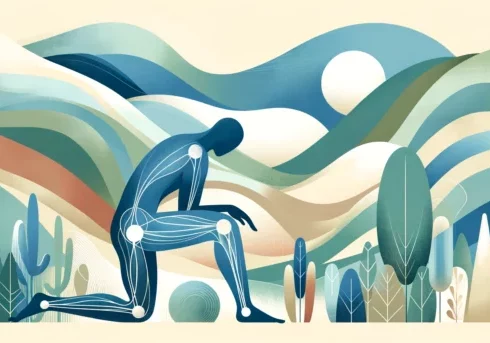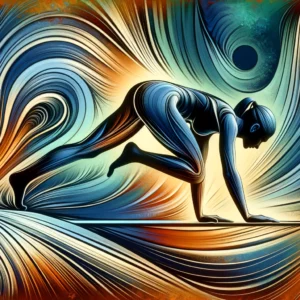Sciatica Stretches and Exercises
Sciatica, a common and often painful condition, can greatly benefit from certain exercises and stretches. Working with an injury rehabilitation personal trainer in Dubai is the perfect way to recover and ease sciatica pain in the long run. An exercise program that is professionally developed will help with this and related issues such as a herniated disc, by focusing on strengthening the core muscles and stabilising muscles in the upper body.
This condition, caused by the compression of the sciatic nerve, leads to discomfort in the back, hip, and outer leg.
Particularly prevalent among older adults, pregnant individuals, and those with obesity, understanding and managing sciatica is crucial for improving quality of life.

While certain exercises can alleviate sciatica symptoms, others may exacerbate them. It's important to avoid activities like squatting, twisting, high-impact sports, and specific core exercises if you're suffering from sciatica.
Read on to shed some light on the nature of sciatica, introducing safe and beneficial stretches and exercises, while also highlighting those you should steer clear of during recovery.
Understanding Sciatic Nerve Pain

Sciatica, often manifested by pain radiating along the sciatic nerve, affects a wide range of individuals with different lifestyles and health conditions.
The sciatic nerve, the longest and widest in the human body, travels from the lower back through the hips and buttocks, extending down each leg.
The development of sciatica, particularly in relation to diverse causes such as aging, weight, lifestyle, and injuries, is vital for effective management and treatment.
The Intricacies of the Sciatic Nerve and Surrounding Tissues
Within the human body, the sciatic nerve is not just a solitary nerve but a complex bundle originating from several spinal nerves.
Surrounding this nerve is a network of connective tissues – including muscles, ligaments, and tendons – that support and provide flexibility to the lower back and hips.
Inflammation, strain, or degeneration in these tissues can compress or irritate the sciatic nerve, leading to the condition known as sciatica.
Various Contexts Leading to Sciatica
Age-related changes in the body, such as natural degenerative processes in the spine, can lead to conditions like disc herniation and bone spurs.
These changes, resulting from spinal disc and joint wear and tear, compress the nerve roots forming the sciatic nerve.
Conditions like lumbar spinal stenosis, characterized by a narrowing of the spinal canal, are also more prevalent in older adults.
In the case of obesity and weight-related factors, excessive body weight increases stress on the spine and accelerates the wear and tear of spinal discs.
This additional weight can also alter posture and walking patterns, thereby increasing pressure on the lower back and hips and exacerbating sciatic nerve compression.
A sedentary lifestyle leads to weakened core and back muscles, poor posture, and increased spinal pressure.
Prolonged sitting, especially with poor posture, can lead to tightness in hip flexors and hamstrings, heightening the risk of conditions like piriformis syndrome.
Injuries and trauma, such as those from car accidents, falls, or sports, can directly or indirectly lead to sciatica. These incidents can cause herniated discs, muscle spasms, or inflammation around the sciatic nerve.
During pregnancy, the body undergoes weight gain, shifts in the center of gravity, and hormonal changes that loosen pelvic ligaments. These changes can place increased pressure on the sciatic nerve.
Occupations or sports involving heavy lifting, prolonged sitting, or repetitive motions can strain the spine and muscles, leading to or worsening sciatica. These risks are heightened in individuals who do not adhere to proper body mechanics.
The Effect of Sciatica on Connective Tissues
Sciatica not only causes pain but also affects the surrounding connective tissues. Muscles may go into spasm as a protective response, which can intensify the pain.
Inflammation in the tissues around the nerve also contributes to the pain cycle.
Approaches to Treatment
Physical therapy, which focuses on strengthening core and back muscles, improving flexibility, and reducing nerve irritation, is often the initial treatment for sciatica.
To manage pain and inflammation, anti-inflammatory medications and cortisone injections are utilized. Surgery may be necessary in severe cases, particularly when significant nerve compression or muscle weakness is present.
Understanding sciatica's complex nature and its impact on the body’s connective tissues is crucial for managing this condition.
Early recognition of risk factors and seeking appropriate treatment can markedly improve the lives of those suffering from sciatica.
Physical Therapy for Sciatic Pain Relief

Physical therapy is an integral component in the management and treatment of sciatica, offering a personalized approach to each patient's unique condition.
This therapy aims not only to alleviate the immediate discomfort associated with sciatica but also to address the underlying causes to prevent recurrence.
Electric muscle stimulation in physical therapy serves as an effective tool for relieving pain and reducing muscle spasms.
By sending mild electrical pulses through the skin to the nerve fibers, this treatment method blocks pain signals sent to the brain.
This stimulation can also encourage the production of endorphins, the body's natural pain relievers, thereby providing significant pain relief.
Hands-on therapies, such as massage and trigger point therapy, are crucial in a physical therapy regimen for sciatica.
Massage therapy helps in relaxing tense muscles, improving circulation, and reducing nerve compression.
Trigger point therapy specifically targets hyperirritable spots in the skeletal muscle that are associated with palpable nodules in taut bands of muscle fibers. The therapy involves applying pressure to these points to alleviate muscle tension and pain.
Hydrotherapy utilizes the therapeutic properties of water to ease sciatica symptoms. Using ice helps in reducing inflammation and numbing sore tissues, providing immediate pain relief.
On the other hand, moist heat therapy enhances blood flow to the affected area, which aids in the healing process and reduces muscle stiffness.
Stretches for Sciatica Pain
Gentle stretching exercises play a vital role in alleviating sciatica symptoms.
They are particularly beneficial after periods of prolonged sitting or during pregnancy when the risk of sciatic nerve compression is higher.
The key to effective stretching lies in following certain guidelines to ensure safety and maximize benefits.

Warm Up
Starting with a proper warm-up is crucial as it prepares the muscles for stretching, reducing the risk of injury. A brief session of light aerobic activity like walking or a stationary bike ride can serve this purpose. The focus should be on avoiding overstretching; stretches should be gentle and controlled. It's important to listen to your body and cease stretching immediately if you experience any pain or discomfort.
Knee to Chest
The Single Knee-to-Chest Stretch is a simple yet effective exercise. It involves lying on your back and gently pulling one knee towards the chest to feel a stretch in the lower back. Similarly, the Double Knee-to-Chest Stretch works on both sides simultaneously, enhancing the stretch along the spine and the muscles of the lower back.
Side to Side Knee Stretch
The Side-to-Side Knee Stretch involves a gentle rotation of the lower back and is particularly useful for those with pinched spinal nerves. Lying on the back with knees bent, the exercise involves slowly moving the knees from one side to the other, thereby stretching different parts of the lower back and hips.
Supine Hamstring Stretches
The Supine Hamstring Stretch targets the back of the thigh, where the sciatic nerve runs. This stretch helps in releasing tension down the leg and into the lower back, offering relief from sciatic pain.
Sciatic Nerve Flossing
Sciatic Nerve Flossing is an advanced technique that helps mobilize and release the sciatic nerve if it's trapped by surrounding tissues. This involves a series of gentle movements that alternately stretch and release the nerve, helping to reduce pain and improve mobility.
Sciatica Pain: Managing at Home
Effectively managing sciatica at home requires a combination of self-care measures and lifestyle adjustments. The goal is to alleviate pain, reduce inflammation, and prevent future flare-ups.
Ice Packs Can Help
Applying ice to the affected area during the initial onset of pain can provide immediate relief. Ice helps in reducing inflammation and numbing the area, thus decreasing pain. As the acute pain subsides, switching to moist heat can further aid in relaxing tense muscles and improving blood flow, which is essential for healing.
Staying Active
Staying active is key in managing sciatica. While rest is important, too much inactivity can worsen symptoms. Gentle activities like walking or stretching can keep the muscles loose and prevent stiffness. It’s crucial to avoid prolonged sitting or lying down, as this can increase pressure on the sciatic nerve.
Over-the-counter pain relievers, such as ibuprofen or acetaminophen, can be effective in managing pain and inflammation. However, these should be used judiciously and as per the recommended dosage.
Listening to your body is perhaps the most important aspect of managing sciatica at home. Recognizing the signs of discomfort and responding accordingly can prevent exacerbation of symptoms. Regularly consulting healthcare providers for guidance and monitoring is also advisable. They can offer advice tailored to individual needs and suggest modifications to home care routines as needed.
Advanced Sciatica Pain Management Techniques
Managing sciatica pain effectively often requires more than just the basic treatments and exercises. Advanced techniques and a comprehensive understanding of the condition can significantly improve the quality of life for those suffering from sciatica. These techniques, when performed correctly and regularly, can offer substantial relief from the discomfort associated with sciatica.
Targeted Therapeutic Exercises
Therapeutic exercises for sciatica are designed to specifically target the areas around the sciatic nerve, providing pain relief and strengthening the surrounding muscles. Core strengthening exercises are particularly beneficial as they help stabilize the lower spine, reducing the pressure on the sciatic nerve. Exercises like the plank, bird-dog, and gentle core twists strengthen the abdominal muscles, lower back, and obliques, offering support to the lumbar spine.
For individuals experiencing leg pain due to sciatica, leg straightening exercises can be helpful. These exercises, such as the standing hamstring stretch, focus on lengthening the muscles in the back of the leg, reducing tension on the sciatic nerve. The scissor hamstring stretch is another effective exercise where one leg is extended forward while the other is extended backward, stretching the hamstrings and relieving pressure on the sciatic nerve.
Specialized Physical Therapy Techniques
Physical therapists often employ specialized techniques for sciatica pain relief. These may include manual therapy to manipulate and mobilize the spine, improving range of motion and reducing nerve irritability. Therapists may also use techniques like nerve flossing or gliding to mobilize the sciatic nerve and relieve entrapment within the surrounding tissues.
For individuals with conditions like herniated discs or spinal stenosis, extension exercises prescribed by a physical therapist can be particularly effective. These exercises involve gentle backward bending of the spine, which can relieve pressure on the nerve roots.
Integrating Lifestyle Changes
In addition to exercises and physical therapy, integrating certain lifestyle changes can significantly aid in managing sciatica pain. Maintaining a healthy weight reduces stress on the spine and can prevent exacerbation of sciatica symptoms. Regular physical activity, tailored to one's condition, improves blood flow and muscle strength, further aiding in pain management.
Proper posture, especially for individuals with occupations involving prolonged sitting or heavy lifting, is crucial. Ergonomic chairs and desks, along with frequent breaks to stretch and walk, can prevent additional strain on the lower back.
Conclusion
Sciatica, a condition that affects many, can be managed effectively with a combination of stretches, exercises, physical therapy, and lifestyle adjustments. Understanding the intricacies of the sciatic nerve and its surrounding tissues, and implementing targeted therapeutic exercises, can provide significant relief from sciatica pain.
Individuals suffering from sciatica should consult healthcare professionals like physical therapists for personalized treatment plans. These plans, often incorporating specialized techniques and exercises, are tailored to address the unique needs of each individual.
By adopting these advanced management techniques and making necessary lifestyle changes, individuals with sciatica can lead a more comfortable and active life. It's important to remember that consistency in performing these exercises and maintaining the recommended lifestyle changes plays a key role in managing sciatica effectively.

